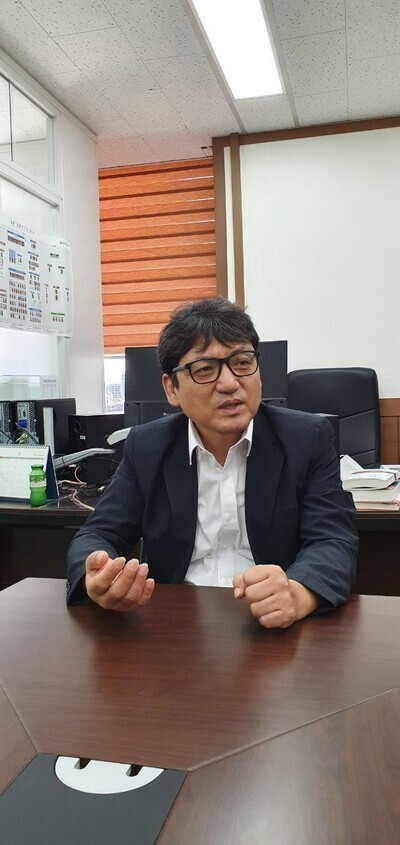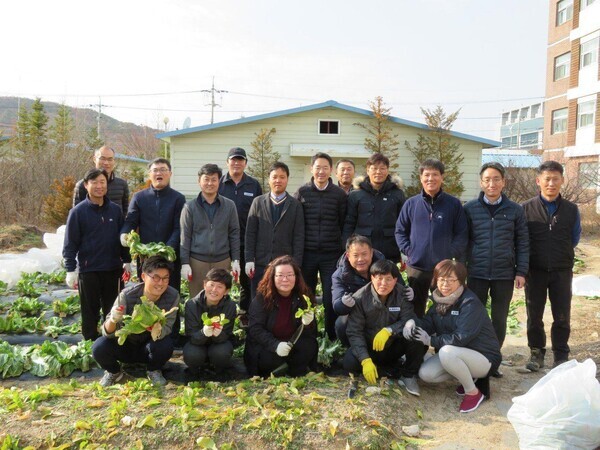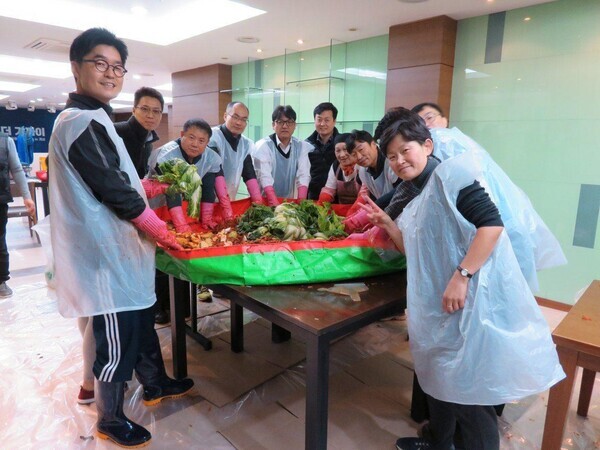hankyoreh
Links to other country sites 다른 나라 사이트 링크
[Interview] Memories from the Inter-Korean Liaison Office

“I’m thinking of making a phone call to the North on the morning of Sept. 14. In my heart of hearts, I’m hoping that some North Korean representative picks up and just says ‘Hello?’ like nothing ever happened.”
A Facebook post with this message was shared on Sept. 13 by Park Jin-won, 54, South Korean secretary-general for the Inter-Korean Liaison Office in Kaesong. Sept. 14 marks two years to the day since that office was opened in accordance with the Panmunjom Declaration proclaimed on Apr. 27 by South Korean President Moon Jae-in and North Korean leader Kim Jong-un.
Today, the building that once housed the joint liaison office lies in rubble -- a “mound of black smoke and twisted concrete.” At 2:50 pm on June 16, North Korea demolished the building to protest defector groups in the South sending propaganda leaflets across the inter-Korean border.
But even if the building was knocked down, the same cannot be said of the South and North Korean people who worked there. The people who shared ups and down in the office over a period of 504 days -- between Sept. 14, 2018, and Jan. 30 of this year, when the COVID-19 pandemic prompted a withdrawal and a promise to “meet again” -- remain with us today, longing for the day when they can return there.
“How wonderful it would be if we could go back to the spirit of that day two years ago when everyone was so excited, celebrating the future of inter-Korean relations and wishing one another well,” Park said -- directing his earnest plea to an autumn sky that only seemed the sadder for how clear and blue it looked.
The joint liaison office was the first true achievement in the 70-year history of Korea’s division, with officials from both sides working together in the same building based on an agreement to establish and operate an office “to allow close discussions between authorities in accordance with the historic Panmunjom declaration and ensure harmonious interchange and cooperation [extending to the private sector],” as the preamble of the office’s establishment agreement stated. Park had been working as a senior administrator in the Blue House National Security Office since the launch of the Moon Jae-in administration on May 10, 2017; in late July 2019, he took on the new position of South Korean secretary-general for the joint liaison office.
Park recalled the four-story building as having “a lot of windows, so it was very sunny inside.” Early in the morning, he would leave his lodgings (five minutes’ driving distance from the office) and step inside the lobby, where the South and North Koreans there would exchange warm welcoming looks before heading to their respective offices -- the South’s on the second floor and the North’s on the fourth. The staffers on both sides held twice-daily “liaison representative discussion meetings” every working day (Monday to Friday), rain or shine, for the 504 days they worked together in the office building. They would also step out onto the second and third floor balconies, respectively, to take smoke breaks.
“It was oddly moving to see the South and North Korean cigarette smoke mingling in the air,” Park reminisced.

Shortly after being posted to Kaesong, Park worked with his North Korean counterparts to plant cabbages in an empty field near the liaison office’s dormitory. “You could call them ‘unification cabbages,’ since South Korean seeds were planted on North Korean soil,” he recalled.
Planting and harvest “unification cabbages” together to make kimchiIn the early winter of last year, they even used the unification cabbages to make kimchi. “I stored it in various refrigerators to maximize their shelf life, but I ended up having to leave before even finishing it all,” Park said with a heavy sigh. There was a reason that Park planted cabbages as soon as he got to Kaesong. “Inter-Korean relations are a matter of connections between people. I believe that connections with people develop into deep roots that are impervious to even harsh winds.”
Looking back on his 504 days working together with the North Koreans in Kaesong, Park said, “It was not a long time, but it was quite eventful, and we achieved considerable things.”

“There were large- and small-scale meetings in areas such as forests, health services, railways, roads, and sports, and South Korea worked together in Kaesong on things like a groundbreaking ceremony for railway and road linkage and a joint excavation of relics from Manwoldae [a Goryeo-era palace site in Kaesong],” he explained, describing how the two sides managed to unravel their tangled skein to produce “collaborative works.” The greatest advantage of the office, he added, was that “when something urgent arose, you could even go to the North Korean dormitory and wake them up late at night to have a conversation.”
“These things were made possible by the joint liaison office,” he said, his voice filled with emotion.
In Park’s view, 2020 has been a “truly difficult year” for all residents of the Korean Peninsula. The year saw an unusually long monsoon season and typhoons descending on a peninsula that was already deeply drained in its ninth month of battling the pandemic.
“Had the joint liaison office been in a sound state, we might have been able to put our heads together all day like we’d been doing to talk about the things South and North Korea could do together to get through this difficult time,” he said. “It’s just been one frustration on top of another.”
Park had predicted that he might return before the weather grew too hot. The indefinite goodbye has continued, but he has no intention of letting go of his hope.
“At the end of our [last] telephone conversation just before the liaison office building was demolished, the North Korean representative said to me, ‘Take care not to catch the virus,’” he recalled. Here’s hoping his unexpected phone call to the North on the morning of Sept. 14 would be met with a hearty laugh and a cry of “Mr. Park, I see you’re well!”
By Lee Je-hun, senior staff writer
Please direct comments or questions to [english@hani.co.kr]

Editorial・opinion
![[Column] Welcome to the president’s pity party [Column] Welcome to the president’s pity party](https://flexible.img.hani.co.kr/flexible/normal/500/300/imgdb/original/2024/0515/3917157400447943.jpg) [Column] Welcome to the president’s pity party
[Column] Welcome to the president’s pity party![[Editorial] Korea must respond firmly to Japan’s attempt to usurp Line [Editorial] Korea must respond firmly to Japan’s attempt to usurp Line](https://flexible.img.hani.co.kr/flexible/normal/500/300/imgdb/original/2024/0514/2317156736305813.jpg) [Editorial] Korea must respond firmly to Japan’s attempt to usurp Line
[Editorial] Korea must respond firmly to Japan’s attempt to usurp Line- [Editorial] Transfers of prosecutors investigating Korea’s first lady send chilling message
- [Column] Will Seoul’s ties with Moscow really recover on their own?
- [Column] Samsung’s ‘lost decade’ and Lee Jae-yong’s mismatched chopsticks
- [Correspondent’s column] The real reason the US is worried about Chinese ‘overcapacity’
- [Editorial] Yoon’s gesture at communication only highlights his reluctance to change
- [Editorial] Perilous stakes of Trump’s rhetoric around US troop pullout from Korea
- [Guest essay] Preventing Korean Peninsula from becoming front line of new cold war
- [Column] The state is back — but is it in business?
Most viewed articles
- 1Major personnel shuffle reassigns prosecutors leading investigations into Korea’s first lady
- 2[Editorial] Korea must respond firmly to Japan’s attempt to usurp Line
- 3US has always pulled troops from Korea unilaterally — is Yoon prepared for it to happen again?
- 4Korea cedes No. 1 spot in overall shipbuilding competitiveness to China
- 5[Editorial] Transfers of prosecutors investigating Korea’s first lady send chilling message
- 6[Column] Welcome to the president’s pity party
- 7Exchange rate, oil prices, inflation: Can Korea overcome an economic triple whammy?
- 8[Column] Samsung’s ‘lost decade’ and Lee Jae-yong’s mismatched chopsticks
- 9Korean auto industry on edge after US hints at ban on Chinese tech in connected cars
- 10Restrictions on corporate bakeries have led to growth for independents